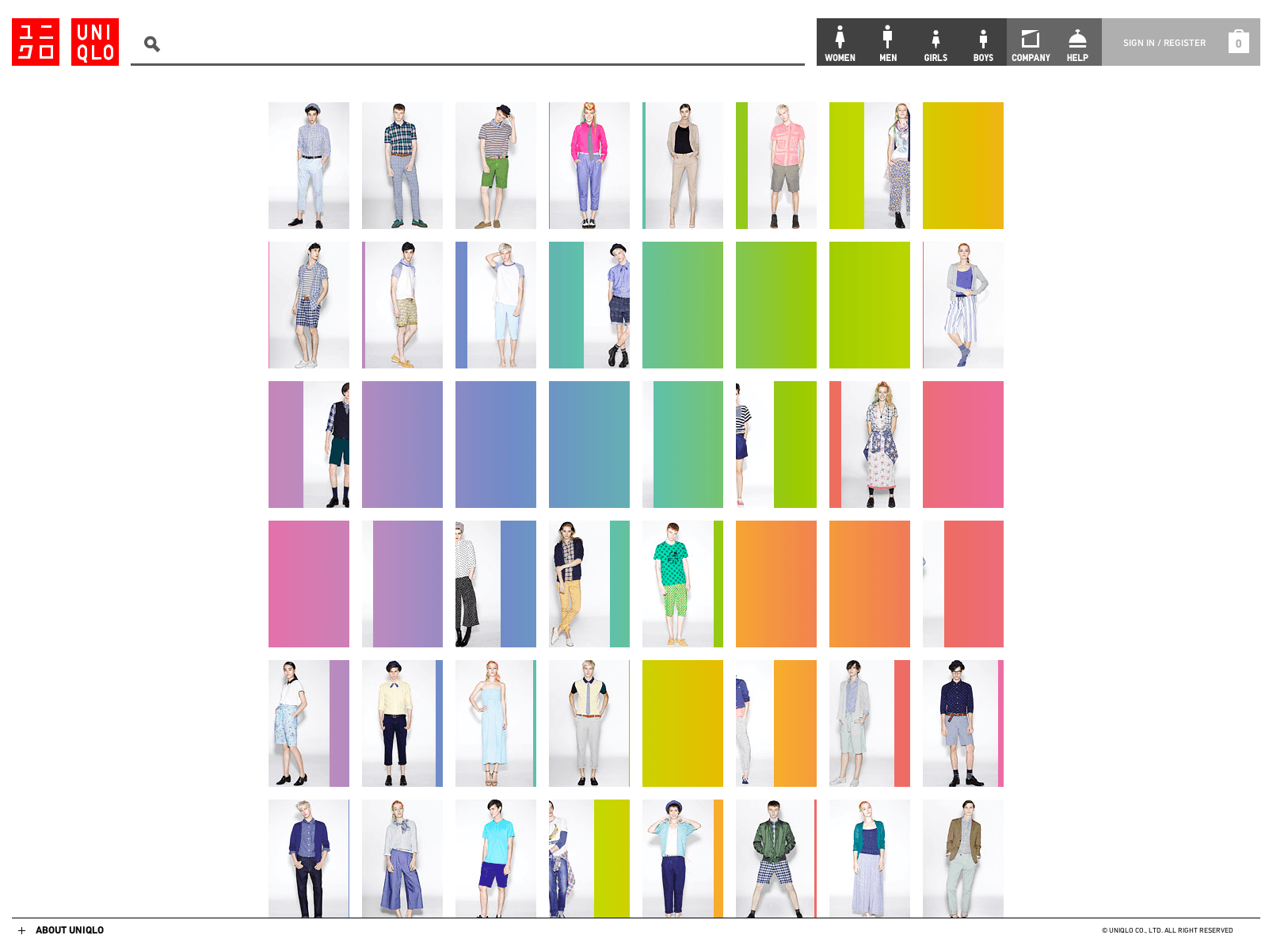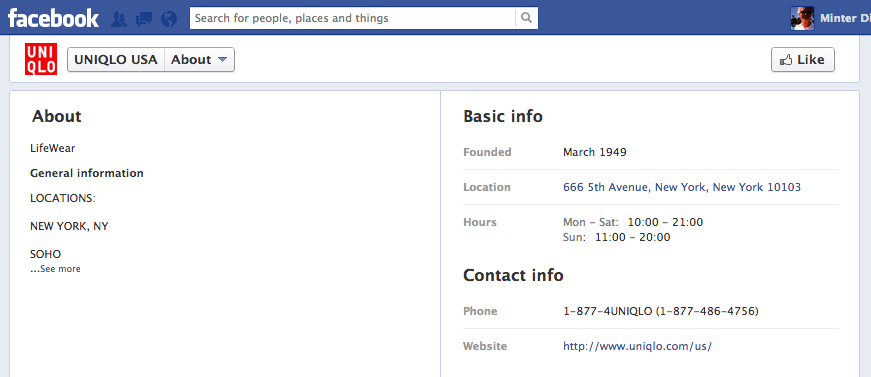
There are some brands that are distinctly and voluntarily mono-cultural; think brands that want to spread a particular way of life (ie. L’Occitane, Hermes…). Then there are brands that have a way of seeming local wherever they may be. Think GAP or H&M. Another brand that has a way of feeling local everywhere is UNIQLO. As the founder says, “UNIQLO clothes are MADE FOR ALL.” This is something of a paradox: uniquely for everyone. Much has been made of the Uniqlo story and in a world of plethoric choices in retail, Uniqlo has certainly made its mark. From a branding perspective, the challenge for a brand to be global and yet feel local is no easy feat. Yet, I believe the UNIQLO strategy seems to be well adapted. In this two-part article, there are four elements of the Uniqlo business I would like to discuss: their global web site strategy, social media marketing, an integrated digital retail experience and innovation. In this post, I will cover the first two elements and will make sure to reference the second post as soon as it is published. Updated with the second post: Uniqlo’s Digitail Experience.
Global web site strategy
Uniqlo has 13 different country-specific websites. And the local teams clearly have latitude when it comes to their site design and home page. There are essentially two different site frameworks; but from there, the pages are all arranged differently. Below is the US page, which is remarkably quick and clean. At each turn, you have different discovery and expandables.

When you return to the (US) site a second time, the experience is different as they provide a quicker access to and focus on the products — and you will have to scroll down a lot to find different “tabs” including their Corporate Social Responsibility (CSR), community and social media activities. They also put prime and center on the home page the opportunity to sign up to their newsletter (the valuable funnel). More importantly, the catch phrase wreaks of integrated marketing savvy: “Get exclusive deals in stores instantly just by showing the confirmation email via your mobile phone.”

Having visited all 13 different sites and observing the differences in format, I note that the content and tone is of course rather consistent. One other salient comment: the pitifully slow load-up of the Chinese site. On balance, there seems to be a rather dynamic, entrepreneurial and integrated approach to their website design.
Social Media Marketing
For starters, each UNIQLO country has their own social media strategy. That may seem an obvious course of action, but it is less easy to execute effectively and efficiently. Each home page of their main site has a direct access to the local social media presence, with more or less emphasis according to the country. Each time, the social media presence is adapted to the most appropriate local channels. For example, in the US and UK, they have Facebook, Twitter and Google+ accounts. Results vary wildly between the different networks. I note that Google+ has 582K +1 in the US vs just 270 in the UK. For the US, the number of +1 on Google+ is double the number of fans on their FB page, which is quite a rare sight. Meanwhile, surprisingly, Uniqlo UK has an equal number of followers on Twitter as the US Twitter account (16K each). Clearly, each subsidiary has implemented different approaches. In France, they are only working on Facebook and Twitter.
In China, they are focused on Renren (190K friends). In Russia, they have aligned themselves with Facebook on the home page (rather than vKontakte which is four times larger than FB). To-date, in Russia, Uniqlo has a little over 2K fans on FB and 1.5K on vKontakte; so neither are setting the world on fire.
Social media communities
The strength of Uniqlo’s social media presence seems to be underpinned by a relatively social culture. For instance, I like the terminology of the #UNIQLOmmunity. Most importantly, most in line with the website strategy, each Uniqlo country has been given the right to socialize as best it sees fit for its country. Whenever I was able to read the content, it was distinctly local. Engagement levels inevitably vary dramatically between the countries. Painful as this may seem to manage, I do believe that they are on the right path. I think this local flexibility is vital in order to succeed in the social media space. The trick is finding ways to synergize between the countries, to encourage constant learning (ie sharing best practices) and to provide access to common digital assets. I would be curious to know how often the social media managers meet to share best practices? Anyone know?
Glocal implies geo-local too

To see where the Uniqlo glocal strategy takes all its weight, they have integrated and encouraged geo-localization. At the bottom of the “About” section of the US Facebook page, they have added a couple of extra relevant links to Yelp and Foursquare (see left). When you go on to Foursquare, for example, you will find Uniqlo stores without any trouble.
Fail harder?

Scouring their various sites around the world, considering their glocal social strategy, it is entirely normal that there will be inconsistencies. The question for the marketing team in HQ is their tolerance for such inconsistencies. Which are deemed innocuous? For example, is it ok that on the Facebook US page they say that Uniqlo was founded in March 1946 as opposed to the Facebook UK page (and the right date) of June 1984? Having worked for many years as the head of a brand worldwide, I know that part of the challenge is just keeping up with what is going on around the world in the different languages, etc. The other is deciding on your level of ambivalence for differences (and, in this case, for mistakes). In the end of the day, perhaps the real question should be: to what extent does each error really impact the brand’s image in the eyes of the beholder? {Click to Tweet out!}
Paraphrasing a Facebook postcard, in order to the glocal strategy right, we must experiment and try harder to fail harder.{Click to Tweet if you like!} Learning to accept one’s mistakes and, better yet, learn from one’s mistakes, is vital.{Tweet Tweet!}
Stay tuned for part 2 of this article with a look at UNIQLO’s innovative digitail experience at their Oxford Street location in the autumn of 2012.
***If you like my writing and are interested in fostering more meaningful conversations in our society, please check out my Dialogos Substack. This newsletter will feature articles on why and how we can all improve our conversations, whether it’s at home, with friends, in society at large or at work. Subscription is free, but if you see value in it, you are welcome to contribute both materially and through your comments. Sign up here:











Trackbacks/Pingbacks